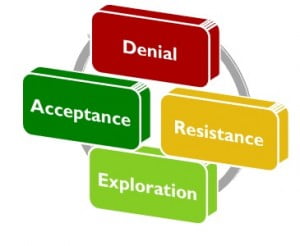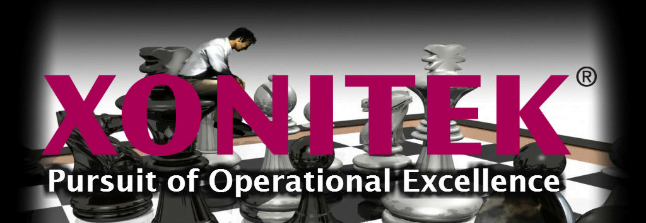3 Mistakes Change Leaders Make, Plus Essential Strategies to Avoid Them
Mistake 1: Leaders fail to prepare themselves for change
I bet there’s not one person reading this article who is not experiencing some kind of change, whether in your work or personal life. Regardless of the type of change, you’re often in the position of leading others through the change. Your role involves helping others to buy-in, take action, and form habits so that the change becomes the new way of doing things.
2 out of every 3 change initiatives fail. Why? Three common mistakes plague leaders early in the process, causing a greater likelihood of failure. Acknowledging and addressing these pitfalls will dramatically improve your odds of success.
- Mistake 1: Leaders fail to prepare themselves for change
- Mistake 2: Leaders fail to clearly communicate and address employee needs
- Mistake 3: Leaders fail to plan for and achieve early momentum
As a leader, you’re often thrown right into action mode, and usually don’t think about the need to prepare yourself for the impending change. Yet, this is one of the most important things you can do. How you prepare yourself for the change you’re leading will significantly impact the outcome.
Let’s look at an example:
Fred was a plant manager for a packaging manufacturer. He had been with the company for years, working his way up from the line. Most factory employees had been with the company for a long time, and had well-established ways of doing things. One day, the company announced a new initiative called Lean Manufacturing. Everyone in the factory was afraid of losing their jobs, including Fred, even though the company communicated otherwise. Fred felt both powerless and forced to follow the company’s instructions. He failed to ask questions and get the information that would alleviate or confirm his personal concerns. Instead, he was stressed and found it hard to be a team player. His employees complained that no one would listen to them or answer their questions. The factory not only fell behind on their project schedule, but soon quality began to suffer as employees became more concerned and less engaged in the change process.
What could Fred have done differently? Why was preparing himself important?
Reacting as the “Victim”
It’s easy to feel like a powerless victim with change happening ‘to you’. However, you do have a choice of either reacting as the victim, or as responsible and accountable. Victims often feel taken advantage of and blame others for what happens. They don’t like to deal with the issues.
We all go through a natural reaction to something that we’re just not quite sure about. A normal human reaction will start at some form of denial, resistance or caution. As you learn more about the change and address your concerns, you can begin to engage in the process, and move through the response stages of exploration and acceptance.
Working Through Your Emotional Reaction to Change
Based on where you start at some form of denial or with questions in mind, you have to become conscious of how you typically move through this response cycle. When you’re going through change, assess where you are in the cycle, uncover your barriers, and move toward an accountable response.
 Answering the following questions will help you with this process:
Answering the following questions will help you with this process:
- What am I being asked to do?
- What does this change mean to me?
- What’s in the best interest of the team?
- What control do I have over the change?
- How are things likely to be different for the better in the future?
- What are the barriers / concerns I need to work through to be able to accept or agree with the change?
- What are my options?
Choose to Lead
You have a choice in how you respond and the actions you take. Not until you address these questions head-on can you get to the point where you are ready to lead your teams through change. As leader, you create energy for your team around the change to keep them engaged, positive, accountable, and keep the momentum going for a successful ending.
Mistake 2: Leaders fail to clearly communicate and address employee needs
When it comes to change, establishing both a clear purpose for the change and a vision of the future state are critical first steps. Leaders need this clarity to lead the change. Employees need this clarity to support and engage in the change. Listening and effective communication round out your strategies for avoiding Mistake 2.
A. Purpose for Change produces the “Wake-Up Call”, building early momentum for the change initiative.
The purpose for change clarifies why change is necessary and creates a sense of urgency that gets things moving. You have to make a case for why doing nothing is a riskier bet. Here are some things to watch out for.
Don’t:
- Assume the need for change is obvious
- Fail to frame the need for change in a way that’s meaningful to stakeholders
- Fail to make the purpose customer-focused
- Fail to check for alignment and build true consensus
- Underestimate the resistance to change
B. Vision creates a clear picture of the future so that supporting behaviors, processes and systems can be clearly defined.
 Change is uncertain and scary. People don’t like change, and they fear the unknown. Therefore, a vision of the future is critical. Your vision is a clear statement about the outcomes and results of your change efforts. Your vision must be customer focused, actionable, and easy to explain and understand. An effective vision provides direction and motivation for the change. Employees, customers and suppliers want to know “What does this mean for me? How will things be different? What will be required of me? How will I continue to contribute and be successful?”
Change is uncertain and scary. People don’t like change, and they fear the unknown. Therefore, a vision of the future is critical. Your vision is a clear statement about the outcomes and results of your change efforts. Your vision must be customer focused, actionable, and easy to explain and understand. An effective vision provides direction and motivation for the change. Employees, customers and suppliers want to know “What does this mean for me? How will things be different? What will be required of me? How will I continue to contribute and be successful?”
Stating the vision in actionable, behavioral terms helps the team gain commitment, while identifying and overcoming sources of resistance. Remember the book “Who Moved My Cheese?” It wasn’t until the character Haw could visualize himself in the future, finding and enjoying the cheese at a new, unfamiliar cheese station, that he was able to move. Help your team visualize that future.
C. Listening to employee concerns and communicating a clear purpose help to overcome resistance and accelerate the change initiative.
There is no time more critical for listening to employee concerns than during a time of change. Our human nature is to want a voice, to be heard, and for our concerns to be taken into consideration. Listening also gives leaders first-hand line-of-sight to potential resistance so that effective strategies can be developed to overcome that resistance.
Humans also have a basic need to know what’s going on, what to expect and what change means on a personal level. Clear and frequent communication builds a sense of trust and camaraderie that “we are in this together.” An elevator speech will help your leadership communicate with a consistent, concise and effective message.
When planning your communications, you must take several factors into consideration….. the communication process, non-verbal cues, verbal cues, and the words and tone used. Remember to think through the Why, Who, What, When, Where & How when developing your communications strategy.
Choose to Lead
By following these strategies of purpose, vision, listening and communication, you’ll avoid making Mistake #2, and will be well on your way to becoming a great change leader.
Mistake 3: Leaders fail to plan for and achieve early momentum
“Nothing diminishes anxiety faster than action.” – Walter Anderson
Therefore, nothing increases anxiety faster than inaction.
Change harbors uncertainty. And, with that uncertainly comes anxiety about the future. When employees are anxious, they often respond negatively, in opposition or by being just plain obstinate. Employees need to feel like they can return to having some level of control over their part of the world.
As a change leader, one of your highest priorities is to eliminate the uncertainty and anxiety. How can you do that? Be strategic about moving employees through the stages of denial to acceptance. This requires creating a sense of movement, a sense of progress toward the vision. There will be challenges along the way and not all things will go as planned. But, you must have a plan… a plan for little signs of progress that can help relieve employees along the journey.
 A. Identify areas or milestones of importance to employees.
A. Identify areas or milestones of importance to employees.
What do employees care about that you can begin demonstrating success around? These are areas that will give employees greater confidence, even if little-by-little, in the change initiative. If the milestone is not important in their sphere of influence, the progress will go un-noticed or its importance minimized.
B. Luck is not a plan
Establish a plan for what you will accomplish, set an achievement goal and a time-frame. You may not be lucky enough to make meaningful progress if you’re not intentional about it.
As you identify the areas or milestones of importance, define what success will look like for each. The progress must be significant enough to begin solidifying movement in the right direction. Set specific targets or goals for what you wish to accomplish, along with timelines. Accountability is also critical. Assign owners and / or teams who will be responsible for these milestones.
C. Communicate your success
Your planning also will include communications – what the milestone was and the progress that resulted. Once a milestone is achieved along the journey, have a plan to share the success with everyone. Be thoughtful about audience, key messages, timing, and communication mode. Don’t forget to include the “so-what”, or what difference the milestone made toward achieving the goal. Remember to also include how the milestone will directly impact employees now and/or in the future.
In his book, “Who Says Elephants Can’t Dance”, Lou Gerstner, former IBM CEO, emphasizes the importance of achieving and communicating purposeful, meaningful and timely progress in turning around a culture. Otherwise, it will take even longer and be harder to get the elephant to even move, let alone dance.
Choose to Lead
Change initiatives can easily derail if not planned and executed carefully. Be proactive. Anticipate the journey and be accountable for mitigating potential challenges. Make sure employees and customers can see and feel steady progress.
Keep the risks of the three mistakes we’ve covered in this series top of mind. Your odds of success will look brighter.
© 2013 EiGL Consulting, LLC
Vivian Hairston Blade is President & CEO of Experts in Growth Leadership Consulting, LLC (EiGL Consulting, LLC) based in Louisville, KY. EiGL Consulting, LLC works with companies to build high performance, high quality, and high service level leaders and teams.
Vivian is a recognized expert, keynote speaker, trainer and executive coach in the principles of Customer Experience, Lean Six Sigma and Leadership Development. She has a deep appreciation and passion for connecting with people. This passion, combined with warmth and humor, resonates with audiences. Through her workshops and presentations, attendees learn tools and tactics to create positive and lasting change for both company and co-worker.
Contact Vivian at 502-419-2733 or vivian.blade@eiglconsulting.com / www.eiglconsulting.com







